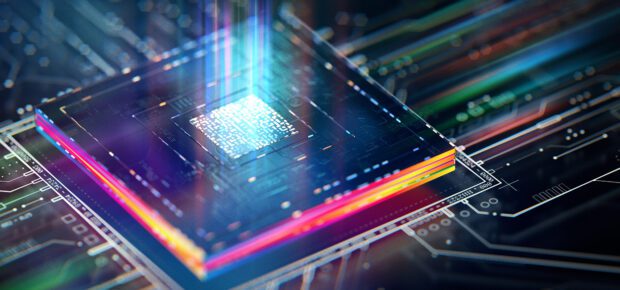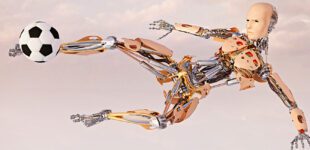June 8, 2023
Experts suggest that quantum computers could unlock the answers to some complex problems in areas like chemistry, cybersecurity and medicine. But unfortunately, some of the building blocks of quantum computing are prone to error. Recent advances in what is called fault-tolerant quantum computing, which enables a computer to handle and fix mistakes, may be part of the solution. Understanding the progression from regular computers to quantum computing and now fault-tolerant quantum computing can seem daunting, so we’re breaking it down for you.
Bits power regular computers. The basic component of a regular computer is like a light switch that can be turned on or off, which we call a “one” or “zero”. These switches are called bits. One bit isn’t very powerful. But when you have millions of bits working really fast – completing one thing after another and another – they can do cool things like run video games or help you make posts on social media.
Qubits power quantum computers. Quantum computers use a “special” switch called a qubit, which has a unique characteristic. Not only can qubits be a “one” or a “zero”, they can be both at the same time. Think of it like a coin – on one side is heads and the other is tails. As long as that coin is spinning in the air, it is both heads and tails.
Quantum computers are super powerful and can do many things at once. As such, quantum computers enable big leaps in computer technology and help solve tough problems around the world.
All computers can generate faults. Regular computers can sometimes switch bits from “one” to “zero.” Quantum computer qubits are really sensitive to their surroundings, and things like electricity, magnets, light or even other qubits can mess up their calculations. These barriers are called faults.
But computers can become fault-tolerant. Regular computers make three copies of the same data and constantly check that data for mistakes. If one copy disagrees with the other two, the computer fixes it.
“We use a trick called redundancy for error correction,” IEEE Member Euclides Chuma explains. “We store the same information on multiple bits. This is called encoding. Then we look for anything that’s not a ‘zero’ or a ‘one’ and fix it.”
And fault-tolerant quantum computers are in development. Qubits can’t be easily copied when they’re in their quantum state, and they can make errors unique to quantum computers. As the number of qubits connected together increases, so too does the difficulty of correcting errors.
Despite this, major players in the field are actively trying to enhance quantum computing. One of the strategies involves dedicating a group of qubits to correct errors in another group of qubits.
“One of the solutions is to develop fault-tolerant quantum computers using superconducting circuits as qubits because this hardware is scalable to thousands of physical qubits,” Chuma said.
However, as of now, quantum computers haven’t surpassed regular computers in performance.
By using these methods, we are moving closer to achieving a more reliable, fault-tolerant quantum computing system – and the implications of that could change the world. For example, a faultless 200 qubit computer could potentially identify chemical catalysts to drastically improve fertilizer production, which would significantly impact global energy consumption and climate change.
Learn more: Quantum computing remains a fast-changing field. The IEEE Standards Association has developed several standards to help researchers define, measure and benchmark quantum. Check them out. Or take a look at IEEE Quantum, which is loaded with approachable videos and articles explaining the intricacies of quantum computers.





 Meaningful Momentum or Running in Place?
Meaningful Momentum or Running in Place? AI Through Our Ages
AI Through Our Ages Liquid Infrastructure: Our Planet's Most Precious Resource
Liquid Infrastructure: Our Planet's Most Precious Resource The Impact of Technology in 2025
The Impact of Technology in 2025 Quantum and AI: Safeguards or Threats to Cybersecurity?
Quantum and AI: Safeguards or Threats to Cybersecurity? Why AI Can't Live Without Us
Why AI Can't Live Without Us Bits, Bytes, Buildings and Bridges: Digital-Driven Infrastructure
Bits, Bytes, Buildings and Bridges: Digital-Driven Infrastructure Impact of Technology in 2024
Impact of Technology in 2024 Emerging AI Cybersecurity Challenges and Solutions
Emerging AI Cybersecurity Challenges and Solutions The Skies are Unlimited
The Skies are Unlimited Smart Cities 2030: How Tech is Reshaping Urbanscapes
Smart Cities 2030: How Tech is Reshaping Urbanscapes Impact of Technology 2023
Impact of Technology 2023 Cybersecurity for Life-Changing Innovations
Cybersecurity for Life-Changing Innovations Smarter Wearables Healthier Life
Smarter Wearables Healthier Life Infrastructure In Motion
Infrastructure In Motion The Impact of Tech in 2022 and Beyond
The Impact of Tech in 2022 and Beyond Cybersecurity, Technology and Protecting Our World
Cybersecurity, Technology and Protecting Our World How Technology Helps us Understand Our Health and Wellness
How Technology Helps us Understand Our Health and Wellness The Resilience of Humanity
The Resilience of Humanity Harnessing and Sustaining our Natural Resources
Harnessing and Sustaining our Natural Resources Creating Healthy Spaces Through Technology
Creating Healthy Spaces Through Technology Exceptional Infrastructure Challenges, Technology and Humanity
Exceptional Infrastructure Challenges, Technology and Humanity The Global Impact of IEEE's 802 Standards
The Global Impact of IEEE's 802 Standards Scenes of our Cyber Lives: The Security Threats and Technology Solutions Protecting Us
Scenes of our Cyber Lives: The Security Threats and Technology Solutions Protecting Us How Millennial Parents are Embracing Health and Wellness Technologies for Their Generation Alpha Kids
How Millennial Parents are Embracing Health and Wellness Technologies for Their Generation Alpha Kids Space Exploration, Technology and Our Lives
Space Exploration, Technology and Our Lives Global Innovation and the Environment
Global Innovation and the Environment How Technology, Privacy and Security are Changing Each Other (And Us)
How Technology, Privacy and Security are Changing Each Other (And Us) Find us in booth 31506, LVCC South Hall 3 and experience the Technology Moon Walk
Find us in booth 31506, LVCC South Hall 3 and experience the Technology Moon Walk Virtual and Mixed Reality
Virtual and Mixed Reality How Robots are Improving our Health
How Robots are Improving our Health IEEE Experts and the Robots They are Teaching
IEEE Experts and the Robots They are Teaching See how millennial parents around the world see AI impacting the lives of their tech-infused offspring
See how millennial parents around the world see AI impacting the lives of their tech-infused offspring Take the journey from farm to table and learn how IoT will help us reach the rising demand for food production
Take the journey from farm to table and learn how IoT will help us reach the rising demand for food production Watch technical experts discuss the latest cyber threats
Watch technical experts discuss the latest cyber threats Explore how researchers, teachers, explorers, healthcare and medical professionals use immersive technologies
Explore how researchers, teachers, explorers, healthcare and medical professionals use immersive technologies Follow the timeline to see how Generation AI will be impacted by technology
Follow the timeline to see how Generation AI will be impacted by technology Learn how your IoT data can be used by experiencing a day in a connected life
Learn how your IoT data can be used by experiencing a day in a connected life Listen to technical experts discuss the biggest security threats today
Listen to technical experts discuss the biggest security threats today See how tech has influenced and evolved with the Games
See how tech has influenced and evolved with the Games Enter our virtual home to explore the IoT (Internet of Things) technologies
Enter our virtual home to explore the IoT (Internet of Things) technologies Explore an interactive map showcasing exciting innovations in robotics
Explore an interactive map showcasing exciting innovations in robotics Interactively explore A.I. in recent Hollywood movies
Interactively explore A.I. in recent Hollywood movies Get immersed in technologies that will improve patients' lives
Get immersed in technologies that will improve patients' lives